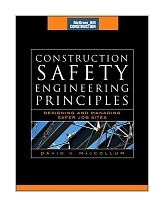IDENTIFY AND CONTROL SAFETY HAZARDS ON CONSTRUCTION SITES TO REDUCE WORKER
INJURIES AND INCREASE PRODUCTIVITY
Construction Safety Engineering Principles equips you with a step-by-step
methodology for identifying and controlling potential hazards before construction begins.
Safety expert David MacCollum presents examples of the 50 most common
construction hazards, showing how they can be eliminated by means of proven design
techniques and technologies. He explains how to prevent falls from elevations with safe
access systems, get rid of blind zones behind mobile equipment, utilize control systems
that cannot be unintentionally activated, avoid crane accidents, and much more. Packed
with detailed illustrations, Construction Safety Engineering Principles enables you to:
- Design and plan safer construction sites for residential, commercial, and
industrial projects
- Correct safety problems before construction begins
- Dramatically reduce costly worked injuries and job delays
- Increase productivity and create a more cost-effective project
IMPROVE SAFETY CONDITIONS ON ANY CONSTRUCTION SITE!
• Hazard Definition (Dormant, Armed, or Active)
• Hazard Prevention through Design Features and Safety Appliances
• Hazard Categories (Natural, Structural/Mechanical, Electrical, Chemical, Radiant
Energy, Biological, Automated)
• Safe Design Hierarchy
• Hazard Identification and Prevention Matrix
• Crane Hazards
• Other Equipment Hazards
• Universal Hazards
• Access Hazards
• Types of Construction
• Operation and Maintenance
• Planning
• Including Safety in the Design
• Including Safety in the Master Construction Plan
• Economics of Safer Design David MacCollum is an award-winning engineer and principal
founder of the Hazard Information Foundation, Inc.
David MacCollum is an award-winning engineer and principal founder of the Hazard
Information Foundation, Inc.
Table of Contents
Acknowledgments
Introduction
Part I: Development of the Five Principles for Safety
Design in Construction
Chapter 1: Principle One: Definition of a Hazard
Chapter 2: Principle Two: The Standard of Care
Chapter 3: Principle Three: Categories of Hazards
Chapter 4: Principle Four: The Safe Design Hierarchy to Physically Control Hazards
Chapter 5: Principle Five: Control the Hazard with the Appropriate Design
Improvement or Appliance
Chapter 6: Reliability: A Method to Evaluate Probable Safety Performance
Part II: Examples of Engineering Control
Chapter 7: Crane Hazards
Section 1: Two-Blocking
Section 2: Crane Upset from Overload
Section 3: Jib-Boom Stowage on Hydraulic Cranes
Section 4: Latticework Boom Disassembly
Section 5: Crane Operator Protection from Upset to Falling Objects
Section 6: Powerline Contact
Chapter 8: Other Equipment Hazards
Section 1: Electronic-News-Gathering Van Powerline Contact
Section 2: Conveyors
Section 3: Skid-Steer Front-End Loader and Rough-Terrain Telescoping-Boom Forklift Side
Upset
Section 4: Trucks
Section 5: Aerial Lifts
Section 6: Unsafe Restraint Systems
Section 7: Equipment Leasing
Chapter 9: Universal Hazards
Section 1: Killer Hooks
Section 2: Blind Zones
Section 3: Dangerous Nuts, Bolts, Pins, and Other Connectors
Section 4: Unsafe Control Systems
Section 5: Guarding of Moving Parts
Section 6: Noisy Equipment and Machines
Part III: Examples of Engineering Control
Section 7: Mold
Section 8: Dust
Section 9: Ventilation
Section 10: Pinch Points
Section 11: Compressed Gases
Section 12: Hazardous Secondary Voltages
Chapter 10: Access Hazards
Section 1: Fall Prevention
Section 2: Fall Protection
Section 3: Falling Objects
Section 4: Ladders
Section 5: Dangerous Access to Equipment
Section 6: Traffic Control
Section 7: Haul Roads
Chapter 11: Types of Construction Hazards
Section 1: Wood-Frame Construction
Section 2: Concrete Form Work
Section 3: Masonry Failures
Section 4: Tilt-Up
Section 5: Lift Slabs
Section 6: Steel Erection
Section 7: Trenching
Section 8: Tunneling
Section 9: Diving/Underwater Construction
Chapter 12: Operation and Maintenance Hazards
Section 1: Fire Prevention
Section 2: Confined Spaces
Section 3: Lighting
Section 4: Toxic Fumes and Gases
Section 5: Wind and Flooding
Section 6: Sanitation
Part III: Mechanics of Inherently Safer Design
Chapter 13: Including Safety into Design Planning
Section 1: Architectural Design Planning
Section 2: Equipment Design Planning
Chapter 14: Including Safety into Construction Planning
Section 1: Construction Safety Planning
Chapter 15: The Economics of Inherently Safer Design
INDEX
416 pages, Hardcover
Księgarnia nie działa. Nie odpowiadamy na pytania i nie realizujemy zamówien. Do odwolania !.


